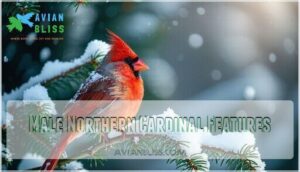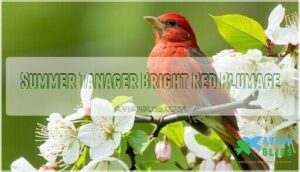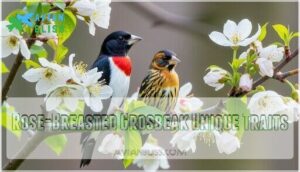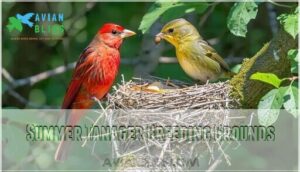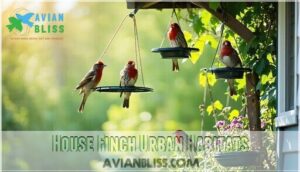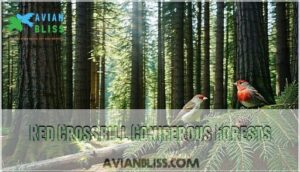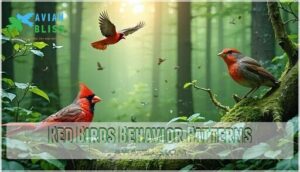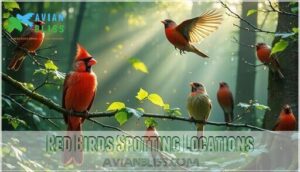This site is supported by our readers. We may earn a commission, at no cost to you, if you purchase through links.

The Northern Cardinal leads the pack – that bright red male with his black mask is practically North Carolina’s unofficial mascot.
Summer Tanagers bring tropical vibes with their all-red plumage, while Scarlet Tanagers flash red bodies with jet-black wings.
Red-bellied and Red-headed Woodpeckers add crimson splashes to tree trunks, and House Finches show off rosy patches on their heads and chests.
You might even spot the rare Red Crossbill in coniferous forests.
Each species has specific habitat preferences and behaviors that reveal surprising secrets about their daily lives.
Table Of Contents
- Key Takeaways
- Red Birds Overview
- Bird Species Identification
- Red Birds Habitat Preferences
- Red Birds Behavior Patterns
- Red Birds Spotting Locations
- Frequently Asked Questions (FAQs)
- What is the difference between a cardinal and a red tanager?
- What kind of cardinals are in North Carolina?
- How to tell the difference between a red bird and a cardinal?
- How do red birds migrate through North Carolina?
- What sounds do red birds make?
- When is best time to photograph red birds?
- Do red birds change color by season?
- How long do red birds typically live?
- Conclusion
Key Takeaways
- You’ll easily identify eight red bird species across North Carolina by learning their distinct features – Northern Cardinals have black face masks, Summer Tanagers are completely red, and Scarlet Tanagers sport black wings.
- You’ll find these birds in specific habitats throughout the state – Cardinals thrive in backyards and suburbs, tanagers prefer mature forests, and woodpeckers favor open groves with dead trees.
- You’ll have the best spotting success during early morning and late afternoon hours at backyard feeders, woodland edges, and parks where food sources and shelter naturally intersect.
- You’ll observe fascinating behaviors like Summer Tanagers catching bees mid-flight, Cardinals cracking seeds with thick bills, and Red-bellied Woodpeckers using specialized tongues to extract insects from bark.
Red Birds Overview
You’ll find eight stunning red bird species across North Carolina’s diverse landscapes, from the familiar Northern Cardinal in your backyard to the brilliant Summer Tanager in mountain forests.
Each species offers unique identification features, preferred habitats, and fascinating behaviors that make birdwatching in the Tar Heel State both rewarding and accessible.
Northern Cardinal Description
You’ll recognize North Carolina’s state bird as the most common red species statewide.
North Carolina’s vibrant state bird brightens backyards and forests year-round with its unmistakable crimson plumage.
Male Northern Cardinals display brilliant red plumage with their signature black mask and prominent cardinal crest.
These seed cracker birds thrive year-round across NC’s diverse habitats, from woodlands to backyards.
- Male Plumage: Vibrant red feathers cover the entire body
- Female Colors: Warm brown tones with reddish wing patches
- Cardinal Crest: Distinctive pointed feather crown on both sexes
- Black Mask: Males feature bold facial markings around eyes
Scarlet Tanager Characteristics
You’ll spot the scarlet tanager by its striking contrast between brilliant red plumage and jet-black wing coloration.
Males showcase this vivid display during breeding season, while female markings appear olive-green with yellowish undersides.
Their molting patterns transform males into dull olive-yellow after breeding.
Listen for their distinctive "chip-burr" call sounds echoing through North Carolina’s deciduous forests, making bird identification easier for enthusiasts tracking red birds and bird species NC.
These birds are common in the state’s Tennessee Valley region, especially during spring, summer, and fall.
Summer Tanager Identification
While the scarlet tanager sports black wings, the summer tanager stands out with its all-over Male Plumage—rosy red from head to tail.
Females show mustard yellow and olive tones, making Female Markings a key bird identification tip.
Juvenile ID can be tricky, with mixed red and yellow. Listen for robinlike Vocalizations, a helpful clue for red bird identification in North Carolina.
Both species, however, migrate to South America for the winter, which is an important aspect of their annual migration.
Red-Bellied Woodpecker Habitat
Red-bellied Woodpeckers thrive in North Carolina’s diverse woodlands and forests, particularly favoring old oak trees, hardwoods, and pines.
You’ll find these adaptable red birds in both rural forests and urban parks.
Their preferred trees provide excellent nesting sites in dead wood, while abundant food sources include insects, nuts, and fruits. Urban adaptation has made them common backyard visitors.
Red-Headed Woodpecker Distribution
You’ll find Red-headed Woodpeckers scattered across North Carolina, though they’re uncommon statewide.
These striking red-headed beauties remain elusive across the Tar Heel State’s scattered woodlands.
These striking north carolina birds prefer open woodlands in the Sandhills and Coastal Plain regions.
Habitat Fragmentation threatens their Population Density, as they need dead trees for nesting.
Conservation Status remains concerning due to declining Range Expansion.
Unlike typical Migration Patterns, they stay year-round where suitable habitat exists.
Fire-maintained ecosystems support the highest concentrations of these distinctive red birds and woodpeckers.
Bird Species Identification
You’ll need to look beyond just color when identifying North Carolina’s red birds, since males and females often look completely different.
Key features like bill shape, size, and distinctive markings will help you tell a cardinal from a tanager or separate similar species at your feeder.
Male Northern Cardinal Features
Male Northern Cardinals instantly catch your eye with their stunning all-red plumage brightness that seems to glow against winter landscapes.
These distinctive north carolina birds showcase remarkable features that make cardinal nc identification straightforward year-round.
- Jet-black mask stretching across the face and throat, creating dramatic contrast with their crimson feathers
- Prominent pointed crest that rises and falls with their mood, adding regal elegance to their silhouette
- Thick orange-red bill shape perfectly designed for cracking tough seeds and nuts
- Rich "birdy-birdy-birdy" vocalizations that ring clearly through neighborhoods and forests
The Northern Cardinal’s vibrant bird coloration makes them unmistakable among red birds in any season.
Female House Finch Characteristics
Unlike their flashy male counterparts, female House Finch display subtle brown plumage with blurry streaks across face and belly.
Their pointed conical bills excel at cracking seeds, while white eye stripes help with bird identification.
This muted female plumage provides perfect camouflage in North Carolina’s varied habitats, from urban feeders to natural woodlands where these adaptable birds thrive year-round with subtle brown plumage.
Scarlet Tanager Distinctive Markings
You’ll spot male scarlet tanagers by their brilliant red bodies contrasted with jet-black wings and tail feathers.
During molting process, males gradually lose their vibrant male plumage, appearing patchy before winter.
Female colors include olive-yellow bodies with darker wings, providing perfect camouflage in North Carolina’s deciduous forests.
Juvenile appearance resembles females but with more streaking, and this red bird identification guide helps distinguish scarlet tanagers from other red birds and bird species nc offers.
Summer Tanager Bright Red Plumage
You’ll recognize Summer Tanager males as North America’s only completely red bird species.
Their bright red plumage develops through molting process and diet influence, with color intensity varying based on genetic factors and nutrition.
- Plumage development: Males gain full red coloration through seasonal molting
- Diet influence: Insect-rich diet enhances vibrant red pigmentation
- Color intensity: Genetic factors determine individual brightness variations
Rose-Breasted Grosbeak Unique Traits
Rose-breasted Grosbeaks display striking plumage dimorphism between sexes.
Males feature bold black and white bodies with brilliant red breast patches, while females show brown streaking with subtle buff coloring.
These North Carolina birds exhibit unique migration patterns, traveling through the state during spring and fall.
Their song uniqueness includes rich, robin-like melodies.
Nesting behavior involves building cup-shaped structures in deciduous trees, making them distinctive among red birds in this thorough bird identification guide.
Red Birds Habitat Preferences
You’ll find North Carolina’s red birds in surprisingly diverse habitats, from your backyard feeders to remote mountain forests.
Each species has evolved specific preferences that determine where you’re most likely to spot them throughout the state, which can be considered a complete concept in understanding their behavior.
Northern Cardinal Favorite Habitats
You’ll find Northern Cardinals thriving in dense shrubs, woodlands, and suburban gardens throughout North Carolina.
These adaptable red birds favor Urban Cardinal Habitats like parks and Suburban Cardinal Niches with thick vegetation for Cardinal Nesting Sites.
They need year-round shelter meeting Winter Habitat Needs, making backyard birds nc enthusiasts appreciate Habitat Conservation efforts supporting diverse bird habitats for North Carolina birds seeking red bird habitat sanctuary.
Their range has expanded due to climate change and urbanization, which is a key factor in understanding the Northern Cardinals‘ adaptability.
Scarlet Tanager Forest Preferences
Among mature deciduous forests, scarlet tanagers show strong preferences for mixed forest composition with adequate canopy height preference.
These red birds favor forest patch size of at least 25 acres, seeking oak-hickory woodlands where insect abundance impact supports their diet.
Bird habitat preferences include deciduous tree species like oaks and maples that provide both nesting sites and foraging opportunities within the forest canopy.
Planting oak tree saplings can help support this habitat.
Summer Tanager Breeding Grounds
Summer Tanager breeding grounds span North Carolina’s open deciduous forests and pine-oak woodlands. These vibrant birds prefer mature mixed forests with clearings, nesting 4-45 feet high in horizontal branches.
Territory Defense occurs through aggressive chasing, while Mating Rituals include male feeding during incubation. Many people also provide backyard Summer Tanager feeders to support these birds.
Parental Care involves both parents feeding nestlings until Chick Development completes in 10-12 days.
House Finch Urban Habitats
You’ll find House Finches thriving in urban areas and suburban neighborhoods across North Carolina.
These adaptable birds nest in building crevices, porch lights, and hanging planters near human activity. City resources like bird feeders attract them to backyards, where they’ve mastered urban adaptation.
Using specialized feeding solutions can further support these urban dwellers. Their success in developed areas makes habitat conservation efforts essential for maintaining healthy populations.
Red Crossbill Coniferous Forests
You’ll find red crossbill in nc birds primarily within western North Carolina’s coniferous forests, where these specialized red birds demonstrate remarkable crossbill adaptations.
Forest management and climate impacts affect cone abundance, making conservation efforts essential for bird watching nc enthusiasts.
Here’s what makes their coniferous trees habitat special:
- Towering evergreen sanctuaries where crossbills feel completely at home
- Abundant pine cones providing their exclusive food source
- Year-round shelter from harsh mountain weather
- Quiet forest depths perfect for raising families
- Ancient woodland stability offering generational nesting sites
Red Birds Behavior Patterns
You’ll discover fascinating behaviors when you watch North Carolina’s red birds closely.
Each species has developed unique feeding strategies and social patterns that help them thrive in the state’s diverse environments.
Northern Cardinal Diet and Reproduction
Northern Cardinals thrive on Cardinal Food Sources like sunflower seeds, safflower seeds, and cracked corn from backyard feeders.
During Breeding Season, these monogamous pairs establish strong bonds.
Females handle Nesting Habits, building cup-shaped nests in dense shrubs using twigs and leaves.
After laying 2-4 eggs, both parents provide dedicated Parental Care, feeding their young insects for protein-rich Chick Development during the critical first weeks.
Summer Tanager Insectivorous Diet
You’ll marvel at this bee-catching expert’s impressive hunting skills.
Summer Tanagers specialize in wasp consumption and demonstrate remarkable foraging techniques when pursuing their insect preferences.
Their bird dietary habits focus heavily on larval diet sources.
Here’s how Summer Tanagers master their insectivorous approach:
- Aerial attacks – They snatch bees and wasps mid-flight with precision timing
- Branch beating – Captured insects get smashed against branches before consumption
- Nest raiding – They’ll tear into wasp nests to access protein-rich larvae
- Seasonal timing – Peak hunting occurs during warm months when insects are most active
Scarlet Tanager Fruit and Berry Consumption
You’ll find scarlet tanagers switching to fruit and berry consumption as summer progresses and insect availability decreases.
Their seasonal diet adapts to habitat impact, with foraging behavior focusing on wild cherries, elderberries, and mulberries.
This scarlet tanager bird diet change reflects fruit availability patterns, making berry nutrition essential for migration preparation and energy storage needs.
House Finch Seed Preferences
House Finch feeding habits center around specific seed preferences that make bird feeders irresistible to these colorful visitors.
You’ll attract more House Finches by understanding their dietary needs and seasonal diet shifts.
Preferred Seed Types for House Finches:
- Black oil sunflower seeds – their absolute favorite with high fat content
- Nyjer (thistle) seeds – excellent for attracting finches year-round
- Safflower seeds – preferred over millet, especially during winter months
Smart feeder placement tips include positioning feeders near shrubs for quick escape routes.
To keep seeds fresh, clean feeders regularly and guarantee proper drainage.
House Finches avoid large seeds like striped sunflower seeds, showing clear aversion seed types preferences.
Red-Bellied Woodpecker Foraging Habits
Unlike House Finches’ seed-focused diet, Red-bellied Woodpeckers showcase remarkable versatility in their foraging habits.
You’ll spot them using specialized tongue adaptations to extract insects from bark crevices, demonstrating unique drumming behavior while searching for food sources.
| Foraging Method | Food Sources | Seasonal Variations |
|---|---|---|
| Bark probing | Insects, larvae | Spring/summer peak |
| Ground foraging | Nuts, acorns | Fall abundance |
| Sap feeding | Tree sap, fruits | Year-round activity |
These Red-bellied Woodpecker foraging locations include mature hardwoods where their bird feeding habits adapt to available resources, making their bird behavior fascinating to observe, especially with their ability to perform unique drumming and utilize specialized tongue adaptations.
Red Birds Spotting Locations
Finding North Carolina’s vibrant red birds becomes easier when you know their preferred hangouts.
You’ll discover these colorful species in specific locations throughout the state, from backyard feeders to forest canopies, which can be considered their preferred hangouts.
Best Places to Spot Northern Cardinals
Success in Northern Cardinal spotting comes from knowing their preferred Urban Cardinal Habitats and seasonal patterns.
These vibrant red birds frequent areas where food and shelter intersect naturally.
- Backyard feeders – Cardinals love sunflower seeds and visit regularly during early morning hours
- Dense shrubs and thickets – Perfect Cardinal Nesting Areas providing cover and protection
- Woodland edges – Where forests meet open spaces, offering diverse food sources
- Suburban parks – Mature trees and landscaping create ideal bird habitats in North Carolina
Scarlet Tanager Migration Routes
Scarlet Tanager migration routes follow predictable bird migration patterns across North Carolina.
These birds enter from the south during April and May, crossing the Gulf of Mexico on nocturnal flights.
Migration timing peaks in spring when tanagers move from South American wintering grounds to breeding areas.
Route variations include movements through North Carolina’s mountains, foothills, and Piedmont regions, with habitat connectivity supporting their journey northward through diverse forest ecosystems.
Summer Tanager Breeding Season Locations
Finding Summer Tanagers during breeding season requires targeting specific habitat selection preferences.
These bird species in North Carolina favor mature deciduous forests with open canopies from May through August.
Climate impact and forest fragmentation affect their nesting ecology, making conservation efforts essential.
Look for them in oak-hickory woodlands and riparian areas where birdwatching locations offer ideal bird habitats for successful Summer Tanager breeding activities.
House Finch Backyard Feeders
House Finch backyard feeders become magnets for these adaptable birds throughout North Carolina.
You’ll attract them easily with black sunflower seeds and nyjer in tube or platform feeders.
Place feeders near shrubs for quick escape routes, avoiding predators while encouraging winter feeding.
These social finches prefer multiple feeding stations, making your yard a reliable spot for consistent House Finch sightings year-round, with consistent sightings.
Red-Headed Woodpecker Groves and Orchards
Red-Headed Woodpeckers thrive in North Carolina’s open groves and orchards where scattered mature trees provide ideal nesting opportunities.
These striking birds prefer habitat with dead trees for cavity excavation, making Orchard Management and Grove Conservation essential for their survival.
Top spotting locations:
- Lake Betz – Open wetlands with tall dead trees
- Weymouth Woods Sandhills Preserve – Longleaf pine stands
- Lake James – Mixed habitats with scattered trees
Their Woodpecker Diet includes insects, nuts, and fruits found in these open environments.
However, red coloring aids in mating rituals and territorial displays.
Habitat Loss threatens populations, making bird conservation efforts essential for maintaining healthy Red-Headed Woodpecker communities across the state’s groves and orchards.
Frequently Asked Questions (FAQs)
What is the difference between a cardinal and a red tanager?
Picture yourself spotting a flash of red in your backyard.
You’ll notice cardinals have black face masks and thick seed-cracking beaks, while red tanagers sport sleek bodies with thin insect-catching bills and distinctive black wings.
What kind of cardinals are in North Carolina?
You’ll find only one cardinal species in North Carolina: the Northern Cardinal.
Males display brilliant red plumage with black face masks, while females show warm brown coloring with reddish highlights on wings, tail, and crest.
How to tell the difference between a red bird and a cardinal?
Cardinals are just one type of red bird—imagine mistaking every red car for a Ferrari.
Look for the cardinal’s distinctive black face mask, thick orange bill, and prominent crest to distinguish it from other red species.
How do red birds migrate through North Carolina?
Most red birds you’ll spot during migration seasons are temporary visitors.
Summer and Scarlet Tanagers pass through North Carolina during spring and fall migrations, while Northern Cardinals stay year-round, making them non-migratory residents.
What sounds do red birds make?
Like a symphony of nature, you’ll hear cardinals’ cheerful "birdy-birdy-birdy" whistles, tanagers’ distinctive "chick-burr" calls, and woodpeckers’ rhythmic drumming echoing through forests and backyards throughout the seasons.
When is best time to photograph red birds?
Early morning and late afternoon offer ideal lighting conditions for photographing these colorful songbirds.
You’ll capture their vibrant plumage best during golden hour when soft, warm light enhances their red feathers beautifully.
Do red birds change color by season?
Most red birds maintain their bright colors year-round, though some species like Scarlet Tanagers molt into duller plumage during winter months for better camouflage and energy conservation.
How long do red birds typically live?
Time flies when you’re watching birds—most red birds in your backyard live 3-15 years.
Cardinals typically reach 13-15 years, while smaller finches average 4-7 years depending on species and environmental conditions.
Conclusion
Observing red birds in North Carolina rewards you with stunning diversity, from Cardinals to Crossbills.
Watching these species teaches you about their unique behaviors, preferred habitats, and seasonal patterns. Learning their identifying features helps you distinguish between similar-looking birds during your outdoor adventures.
These red birds in North Carolina offer year-round viewing opportunities, whether you’re exploring forests, visiting feeders, or hiking mountain trails. Each species contributes to the state’s rich avian tapestry through their distinct calls, feeding habits, and nesting preferences, making the experience of observing them truly stunning diversity, with opportunities for year-round viewing, and a chance to learn about their unique behaviors.
- https://ncwf.org/blog/cardinals
- https://www.allaboutbirds.org/guide/Northern_Cardinal/overview
- https://www.sigloxxi.com/birds-of-north-carolina-a-guide-to-red-orange-and-yellow-species
- https://abcbirds.org/bird/summer-tanager
- https://www.pinterest.com/pin/11-types-of-red-birds-in-north-carolina-nc-with-pictures--620722761162302568

